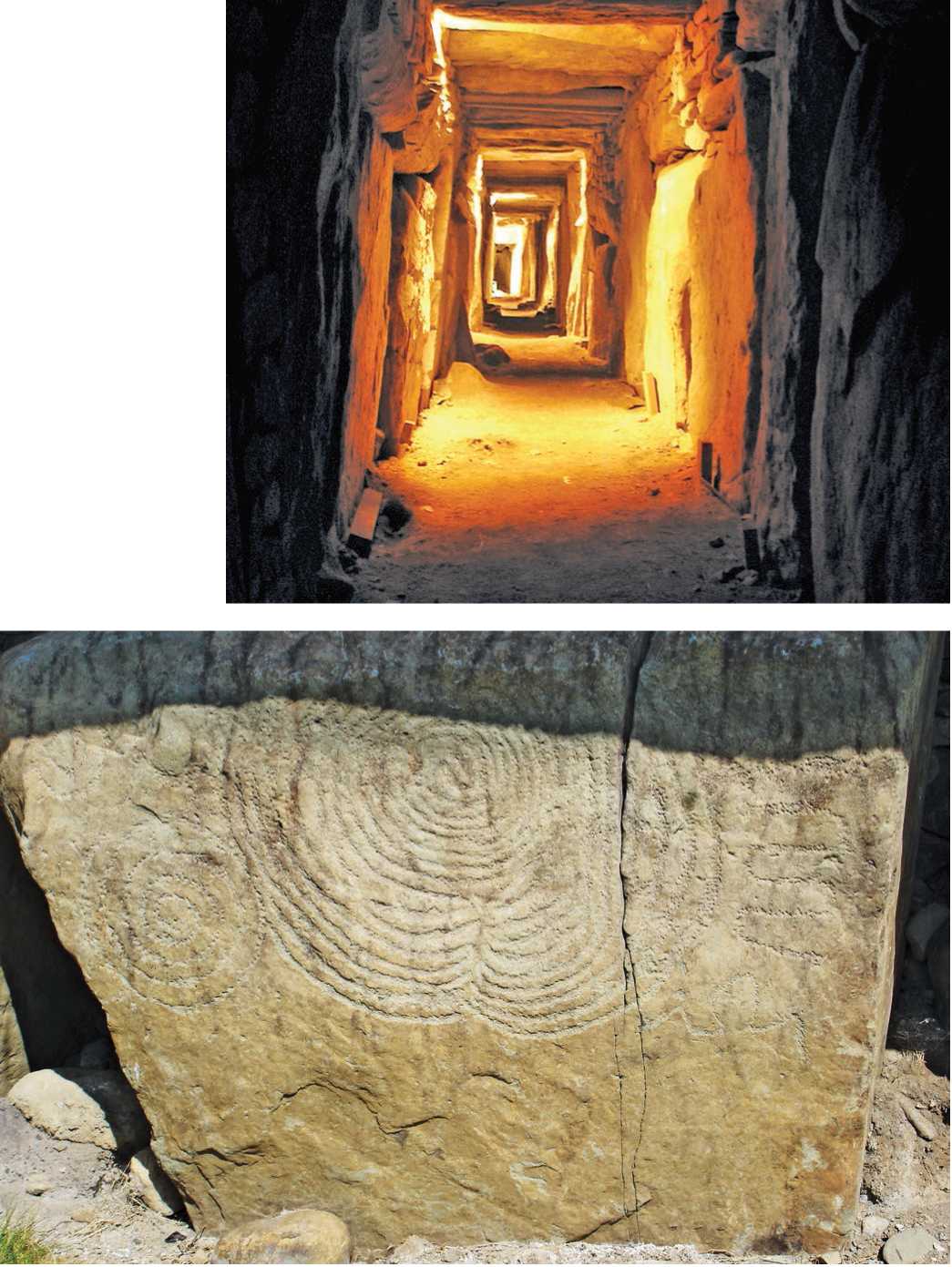The Beaker people arrived in England when the wooden and stone circle was already in full fashion. But whereas in many places this tradition simply continued, at Stonehenge, the newcomers took it upon themselves to radically alter its design. The builders removed some of the stones of the old ring, and added a new ring of sixty large “bluestones” to the interior. The term “bluestone” is not a real geological term, but used by archaeologists to describe nonregional stones. The stone is actually a medium-grained, dark, heavy rock known as spotted doler-ite since it contains spots of plagioclase feldspar. It is remotely possible that the stones came from Carn Menyn, some 200 linear kilometers to the west. How the stones were brought to Stonehenge is not clear. Why from this place is also not clear, except that even today the rocky outcrops are striking in their shape and must have had a special resonance in ancient times. Today it is generally thought that the stones came from closer to the building site and that they were what are called glacial erratics, namely stones that had been deposited in the area when the glaciers melted.
Regardless of where the stones came from, it was not just the addition of the new ring that made these efforts so unusual. Builders moved the Heel Stone a few meters, rotated the axial focus of the monument by a few degrees, and widened the entrance. It was a labor-intensive effort that transformed Stonehenge from a lunar to a solar observatory. In the process, the Beaker culture people also transformed Stonehenge from a local temple to a larger regional ritual center, filling the area for miles around with their circular burial mounds. Their wealth shows in the graves. In one, archaeologists found gold ornaments as well as bronze pins from Bohemia, blue faience beads from Egypt, and amber beads from northern Europe. A village was created to the northwest, Durrington Walls, which was defended by a circular defensive wall, 480 meters across.
No sooner had the Beaker people completed their work in or around 2300 bce than Stonehenge underwent yet another and even more impressive transformation. The new designers no longer belonged to the Beaker culture, which seems to have died out afi:er a few hundred years. The new builders were now working at the behest of a culture represented by chieftains whose numerous cemeteries were added to the landscape around Stonehenge. Their origin is even more mysterious than that of the Beaker people. The new overlords removed the bluestones that had been put there by the Beaker people and added the now famous Sarsen Ring of trili-thons, Sarsen being the name of the local sandstone boulders. The ring, 33 meters across, was composed of 30 enormous stones with an average weight of 26 tons. The transportation of the blocks from a site 30 kilometers away would have been a feat in itself. Particularly noteworthy was the effort made in the preparation of the stones. Moving in unison and using stone mauls swung on ropes, workers pummeled the surface of the boulders to pulverize protrusions, first with large mauls the size of pumpkins and then moving down in size to mauls the size of tennis balls. When the surfaces were finally flat, other teams were set to work rubbing the surfaces with large flat stones, back and forth like a woodworker with sandpaper. When they were done, the posts measured 4.1 meters high, 2.1 meters wide, and 1.1 meters thick. They were surmounted by thirty 6- to 7-ton lintels that formed a continuous circle around the top.
The precision was remarkable. The tops of the lintels, once they were in place, never varied more than 10 centimeters from the horizontal. Such carefully worked stone is not typical of other English henges where the stones were not only brought from closer in but were left natural, perhaps because they were seen as possessing a magical, chthonic presence. The Sarsen Ring was architecture of a particular type, for it was in reality something akin to carpentry in stone. The sanding of the surfaces, and the way in which the stones were fitted together, all seem to imply a direct application of the techniques of carpentry to stone. Possibly the designers were replicating in stone a wooden prototype, or perhaps they were seeking to enhance the power of the stone structure by embodying in it the more familiar techniques of woodworking.
Figure 10.73: Knowth, River Boyne, Ireland. Source: Brholden (Public Domain)

Figure 10.72: Knowth, River Boyne, Ireland. © Przemystaw Sakrajda (Http://creativecom-mons. org/licenses/by-sa/3.0/ deed. en)
Stonehenge went through yet another transformation. In this final phase some of the blue-stones that had been removed were brought back to the site with some being erected within the Sarsen Ring and others placed in a horseshoe configuration. Such a horseshoe was uncommon in England, but occurred more frequently across the channel in Brittany. The implications of this have yielded much speculation, but it is almost certain that southern England and French Brittany in this phase were part of a single cultural province.
The new chieftain culture was also responsible for several other amazing structures, including Silbury Hill (2400 bce) . At 40 meters high, 167 meters across, it the largest man-made hill in Europe. Although today it is a cone, it seems that originally it was a nine-sided stepped structure, surrounded by a ditch, from whence the material was taken. It was a huge undertaking. Another impressive structure was the elaborate mound Knowth (between 2500 and 2000 bce), which was built on similar principles to the older Newgrange just to the northwest of that eminent mound (Figures 10.72 and 10.73). It consisted of a mound surrounded by eighteen smaller passage graves. 50
Although the age of stone circles and large tomb structures was coming to a close, there was clearly enough wealth and energy to build the impressive Ring of Bordgar (between 2500 and 2000 bce).




 World History
World History









